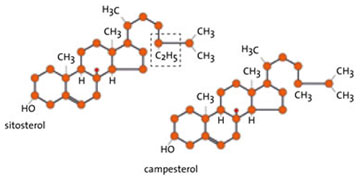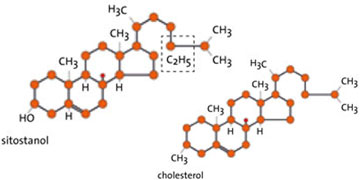Most of us love eggs. What’s not to like about them? Yet we should be aware of the cholesterol they contain, especially because cholesterol is said to increase the risk of cardiovascular disease. Cholesterol itself isn’t bad so it shouldn’t be banned from our diet. There is however an indisputable link between high levels of cholesterol in our blood and cardiovascular disease. The symptoms were formerly known as arteriosclerosis (sclerosis = hard) because the arteries became ‘harder’ and thicker as a result of sediments.
Those sediments on the blood vessel wall are not calcium plaque as was long believed, but rather plaques that contain greasy substances. The accumulation of these elements can lead to blood vessel narrowing that hinders the blood flow or even cause total blockage. If this happens in the coronary artery, it can lead to strokes and heart attacks. Not so long ago it was common belief that excessive intake of foods high in cholesterol was the main cause of increased cholesterol levels in the blood. Scientists have now come up with a more balanced view of cholesterol, as more facts became known about the cholesterol metabolism.


Structural formulas of the animal cholesterol and the vegetable sterols sitosterol, campesterol and sitostanol
The role of cholesterol
Cholesterol is found in almost every cell in our body and there are obviously many reasons for that. Cholesterol has many different functions without which our bodies wouldn’t be able to function properly. It is a structural component of cells and it is required to build and maintain membranes. Furthermore, it is an important component for the manufacture of vitamin D, bile liquid (that helps digest fat), reproductive hormones and hormones for the cortex of suprarenal gland. Cholesterol is also a component of lipoprotein carriers that transport fat from the digestive tract to the various body cells.
A certain amount of cholesterol is needed for the body to function properly. On average, our bodies produce larger amounts of cholesterol in the liver and intestines than we consume through food. Our own cholesterol production partially depends on the amount of cholesterol we consume. An average body produces between 600 and 800 mg of cholesterol per day, whereas the intake of cholesterol through foods high in cholesterol only amount for 200 to 300 mg per day. An average egg (approximately 60g) contains 260 mg of cholesterol.
Cholesterol metabolism and ‘bad’ versus ‘good’ cholesterol
In order to explain food industry claims such as ‘lowers cholesterol’, we should elaborate a bit on this matter. Cholesterol travels around the body as a component of lipoproteins. They are classified by density into LDL (Low Density Lipoproteins) and HDL (High Density Lipoproteins), also known as ‘bad’ and ‘good’ cholesterol.
LDL cholesterol is chiefly involved in the transport of the cholesterol manufactured in the liver to the tissues, where it is used. The excess of cholesterol is absorbed by the HDL particles and carried to the liver for reuse. The leftover cholesterol is expelled out of the body along with feces. Higher levels of LDL particles compared to HDL particles increase the risk of coronary disease. This happens because the excess of LDL particles accumulates on the walls of the arteries instead of being transported to the liver. So, when measuring cholesterol levels, you should not only take into account the total cholesterol level but also the proportion between LDL and HDL.
Research has shown that food high in unsaturated fatty acids – such as fatty fish with omega-3 fatty acids (EPA and DHA) – increase the level of HDL particles in the blood. HDL particles contain relatively low amounts of cholesterol, which is readily carried to the liver. The food industry came up with the claim ‘cholesterol-lowering’ for these foods. They are the opposite of foods with lots of saturated fats that increase the level of LDL particles. In popular language those saturated fats are often called ‘bad’ fats versus the ‘good’ fats (oils) with high levels of unsaturated fatty acids.